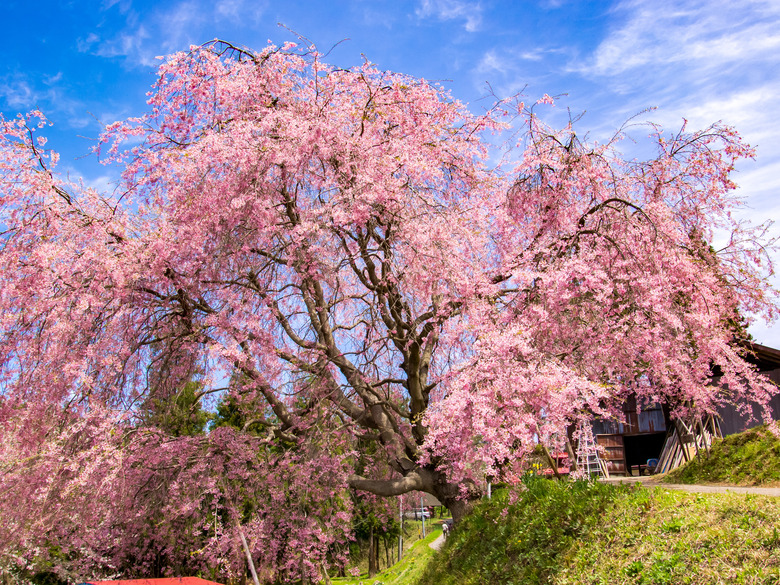About Weeping Cherry Trees
We may receive a commission on purchases made from links.
The weeping cherry or weeping Higan cherry (Prunus subhirtella 'Pendula,' USDA zones 4-8) is an ornamental flowering tree capable of growing 15 to 40 feet high. The weeping cherry tree is native to China but is now closely associated with Japanese culture. The Japanese refer to weeping cherry trees as "shidarezakura."
Physical Characteristics of Weeping Cherry
Physical Characteristics of Weeping Cherry
A weeping cherry tree features "weeping" branches that trail toward the ground instead of growing upright. It blooms heavily in early spring, features glossy-green leaves in the summer and produces black, inedible berries in late summer. Even when its leaves drop for winter, the weeping cherry continues to provide visual interest thanks to its delicate arching branches.
The blossoms can be either pale pink or white. Some varieties produce five-petaled flowers, whereas other varieties produce blossoms with more than five petals. It's one of the first trees to bloom in the spring, providing an important source of food for pollinators. A few months later, it again serves as a food source, this time for the birds that enjoy its sour berries.
Life Span of Weeping Cherry
Life Span of Weeping Cherry
Most weeping cherry trees will only live for about 10 to 20 years in North America, even when they receive the best care. However, when they're grown in Japan where the climate is similar to the tree's native China, weeping cherry trees have been known to live for hundreds of years.
For example, one famous weeping cherry tree is located in Maruyama Park in Gion, Japan. The first Gion cherry tree lived for over 200 years and finally died in 1947. The current specimen planted in Maruyama Park is over 90 years old.
Another weeping cherry tree (Prunus subhirtella 'Pendula Rosea') located in Miharu, Japan is reportedly over 1,000 years old. Known as Takizakura or "waterfall cherry tree," it still blooms to this day. To help your weeping cherry tree grow as long as possible, inspect it regularly for signs of fungal infections and pests, as they are highly susceptible to both.
Growing Conditions for Weeping Cherry
Growing Conditions for Weeping Cherry
Weeping cherry trees prefer cool weather versus extreme heat, so if you try to grow one in a warmer climate, consider planting it in an area where it receives morning sun and afternoon shade. It's also helpful to mulch the roots generously to keep them cool.
Weeping cherry trees also thrive when the temperatures stay consistent. Extreme and rapid fluctuations in temperature can stress this plant. If the temperature in your area is unpredictable, consider growing a dwarf weeping cherry tree in a pot so that you can bring it indoors when temperatures threaten to quickly rise or drop. It's also important to provide consistent moisture to a weeping cherry tree. Don't allow the roots to dry out but don't drown them either.
Interesting Weeping Cherry Cultivars
Interesting Weeping Cherry Cultivars
To enjoy even more flowers, plant Prunus subhirtella 'Autumnalis,' which blooms a second time in the fall. However, its dense foliage often hides the flowers, leading to a less showy display compared to the spring bloom.
Prunus x 'Snow Fountains' is a small variety that matures to about 12 feet high and wide. If grafted onto a dwarf rootstock or kept pruned, it is suitable for growing indoors. When grown outdoors, pests — especially Japanese beetles — should be kept well-controlled.
For a weeping cherry that produces pink flowers rather than white flowers, plant Prunus subhirtella 'Pisnshzam,' also known as 'Pink Snow Flowers.'
